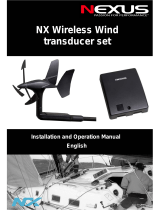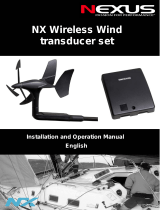
Sea Data Set TH52 English
3
1 Part specification ..............................................................................................................5
2 Installation .........................................................................................................................7
2.1 Installing the instrument ...................................................................................................8
2.2 Installing the WSI-box ......................................................................................................9
2.3 Installing the Log and depth transducers .......................................................................10
2.3.1 Correct location of transducer .............................................................................10
2.3.2 Installing the through hull fittings.........................................................................12
3 Installation .......................................................................................................................12
3.1 Bedding ..........................................................................................................................12
3.2 Installing.........................................................................................................................12
3.3 Checking for Leaks.........................................................................................................14
3.4 Installation in a Cored Fiberglass Hull............................................................................14
3.5 Electrical Installation.......................................................................................................16
4 First start..........................................................................................................................17
4.1 Initialising the instrument................................................................................................17
4.2 How to use the push-buttons of the Sea Data................................................................18
4.3 Instrument backlight.......................................................................................................19
5 Function overview of the Sea Data................................................................................19
6 SPEED functions.............................................................................................................20
SPEED main-function.................................................................................................................20
SPEED sub-functions.................................................................................................................20
TRIP LOG (TRP) ....................................................................................................................20
TOTAL LOG (LOG).................................................................................................................20
START TIMER (STA).............................................................................................................20
TIMER ....................................................................................................................................20
AVERAGE SPEED (AVS) ......................................................................................................20
MAXIMUM SPEED (MAX)......................................................................................................21
DEPTH (unit/DPT)..................................................................................................................21
BATTERY (BAT).....................................................................................................................21
TEMPERATURE (TMP) .........................................................................................................21
7 DEPTH functions.............................................................................................................22
DEPTH main-function.................................................................................................................22
DEPTH sub-functions.................................................................................................................22
LIGHT CONTROL...................................................................................................................22
SHALLOW ALARM (SHA)......................................................................................................22
DEPTH ALARM (DEA)...........................................................................................................22
ANCHOR ALARM...................................................................................................................22
BOAT SPEED (BSP/unit).......................................................................................................22
Barometric pressure (unit/hPA)..............................................................................................22
7.1.1 TRUE WIND ANGLE (TWA)................................................................................22
7.1.2 APPARENT WIND ANGLE (TWA)......................................................................23
7.1.3 TRUE WIND SPEED TWS..................................................................................23
7.1.4 APPARENT WIND SPEED (AWS)......................................................................23
7.2 Set shallow (SHA) and depth alarm (DEA).....................................................................23
7.3 Set and turn on anchor alarm (ANC)..............................................................................23
7.4 Clear an alarm value ......................................................................................................23
7.5 Silencing an alarm..........................................................................................................24
7.6 Turning OFF or ON an alarm..........................................................................................24
8 Customise your display..................................................................................................25
8.1 Move and lock a sub-function.........................................................................................25
8.2 Copy and lock a sub-function.........................................................................................25
8.3 Select power on function................................................................................................25
8.4 Cancel a moved or locked sub-function.........................................................................25






















